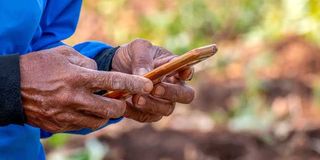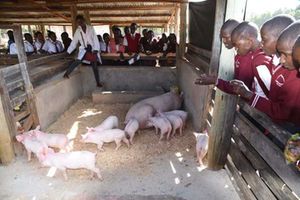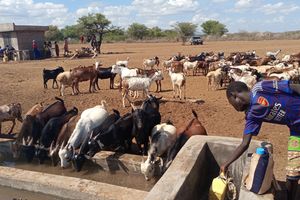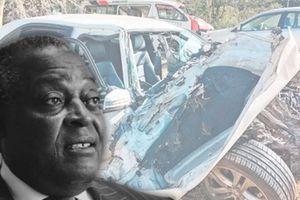
A farmer uses a smartphone. People are demanding more efficient, readily available and non-physical services wherever digital technology is applicable.
As technology and communication improve, some conventional methods of medical services in animals and humans as well as crop farming will inevitably change.
People are demanding more efficient, readily available and non-physical services wherever digital technology is applicable.
I have included crop agriculture under health services because even plants get diseases and need to be treated. There is the role of crop farming experts that is called plant health services.
We know more about the use of pesticides in crop farming to kill insects and other disease-causing agents. But plants also have bacteria and viruses that cause diseases such as the tobacco mosaic virus or bacterial wilt in tomatoes and passion fruits.
Some crop farmers call agriculture service providers and request them to diagnose and treat diseases on their plants to avoid paying the visit or chemical application fees.
I have received questions from livestock farmers, wondering if long-distance diagnoses and treatment are appropriate and effective.
One said her animal health service provider listens to the case history by phone, diagnoses the problem and then prescribes medicine for the farmer to buy and give the sick animal, according to the instructions given by the drug seller.
The farmer complained that in many cases, she ends up calling a doctor to visit the animal physically, diagnose the problem and treat the animal.
She ends up incurring higher costs than she would have if the animal health service provider had started by visiting the farm.
The observation of the farmer is correct because in a majority of cases, an animal health service provider may not be able to tell the real cause of a disease without physically examining the patient.
Unlike humans who normally tell the doctor how they feel during an illness, animals are diagnosed, based on the history of the case given by the caregiver and the doctor’s examination and analysis of the findings to make a diagnosis.
Incidentally, even in humans, healthcare providers are likely to make mistakes if they diagnose diseases on the phone without physically examining the patient.
It is also known that sometimes animal owners may be biased in giving the case history and observations to a health care service provider to match the farmer’s opinion on the problem with the animal.
Another problem with phone diagnosis and treatment is that the farmer may get the medicine the doctor has prescribed changed by the medicine supplier without consulting the prescribing doctor.
Ineffective or lower quality drugs may then be bought and the animal either takes long to recover or do not recover.
Last week, a farmer from Nyeri called, saying his animal had been treated for diarrhoea but the healing was slow.
I concluded she needed to change the medicine and prescribed a drug that is normally highly potent in treating bacterial diarrhoea in ruminants.
She would give the medicine by mouth, once daily for five days. I asked her to report to me the progress on the third day of treatment.
After three days, the farmer called and reported the cow had shown some improvement but was still unwell.
I asked her to confirm the medicine she bought. It turned out it was a poorer version of the one I had prescribed.
Drugs may have the same ingredients in the brand but some companies may make substandard medicines.
Doctors keep monitoring the performance of various brands of drugs as they use them and make their preferences when prescribing.
Farmers are advised to stick to the drugs prescribed but consult the prescribing doctor if they need to change.
The farmer told me the medicine had been changed by the seller at the agrovet.
Under normal circumstances, the person dispensing a prescription should always consult the doctor who wrote the prescription before substituting the drugs prescribed.
Another reason the doctor should visit the farm and examine animals physically is that diseases are a product of the environment, type of animals and management practices.
To understand the disease factors, the doctor needs to make lots of observations in the status of the herd, the environment and how the herd is managed.
This helps the doctor not only to diagnose and treat the problem for the sick animal but also advise the farmer on how to minimise disease occurrence on the farm.
I recall one time I visited a farm in Kiambu where a cow had been reported to have a poor appetite. It had also been wasting and having intermittent diarrhoea for about two months.
Sometimes the animal would stay for some time without passing dung.
On arrival at the farm, I was surprised to see the feed being given to the animals had long pieces of overgrown Napier grass stems. The area was also next to a shopping centre.
There were plastic papers strewn in the pasture paddocks.
There were about 15 cattle on the farm. Some had distended abdomens and appeared unhealthy.
I examined three cattle in total, including the ill one. The sick animal and two others turned out to be having blockage of the intestines or stomach.
I told the farmer there was no way of determining whether the other cows had any partial blockage or had already swallowed foreign material.
The sick cow died before I could do surgery to remove blockage material from the stomach.
When I did a postmortem, I found the cow had blockage of the stomach by fibre balls due to consuming the pieces of overgrown Napier, clothing and plastic material.
I would never have made the discoveries had I made the diagnosis and treatment over the phone.










